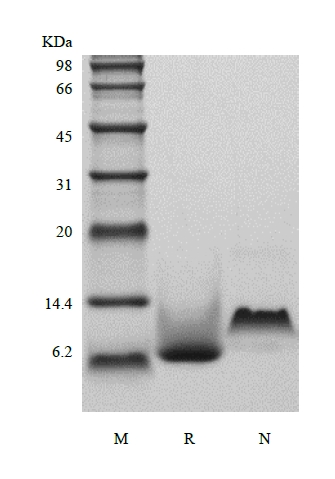| Official Full Name |
Recombinant Human Growth Regulated Protein-beta/CXCL2 (rHuGRO-beta/CXCL2) |
| Squence |
 |
| Amino Acid Sequence |
APLATELRCQ CLQTLQGIHL KNIQSVKVKS PGPHCAQTEV IATLKNGQKA CLNPASPMVK KIIEKMLKNG KSN |
| Synonyms |
MIP2-alpha |
| Accession Number |
P19875 |
| GeneID |
2920 |
| Summary |
CXCL2, also named GRO-β, is belonging to the CXC chemokine family. It is encoded by the gene CXCL2 in humans. CXCL2/GRO-β shares 90 % amino acid sequence with CXCL1/GRO-alpha. All three human GROs (GRO-alpha, GRO-β, GRO-gamma) are members of the intercrine alpha (chemokine C-X-C) subfamily of chemokine. This chemokine is secreted by monocytes and macrophages. The functional receptor for CXCL2 has been identified as CXCR2. CXCL2 is chemotactic for polymorphonuclear leukocytes and hematopoietic stem cells. Similar to other GRO proteins, CXCL2 is potent neutrophil attractants and activators. In addition, it is also active toward basophils. |
| Source |
Escherichia coli. |
| Molecular Weight |
Approximately 7.9 kDa, a single non-glycosylated polypeptide chain containing 73 amino acids. |
| Biological Activity |
Fully biologically active when compared to standard. The biological activity determined by a chemotaxis bioassay using human CXCR2 transfected human 293 cells is in a concentration range of 10-100 ng/ml. |
| Appearance |
Sterile filtered white lyophilized (freeze-dried) powder. |
| Formulation |
Lyophilized from a 0.2 um filtered concentrated solution in 20 mM PB, pH 7.4, 50 mM NaCl. |
| Endotoxin |
Less than 1 EU/ug of rHuGRO-β/CXCL2 as determined by LAL method. |
| Reconstitution |
We recommend that this vial be briefly centrifuged prior to opening to bring the contents to the bottom. Reconstitute in sterile distilled water or aqueous buffer containing 0.1 % BSA to a concentration of 0.1-1.0 mg/mL. Stock solutions should be apportioned into working aliquots and stored at ≤ -20 °C. Further dilutions should be made in appropriate buffered solutions. |
| Stability and Storage |
Use a manual defrost freezer and avoid repeated freeze-thaw cycles.- 12 months from date of receipt, -20 to -70 °C as supplied.- 1 month, 2 to 8 °C under sterile conditions after reconstitution.- 3 months, -20 to -70 °C under sterile conditions after reconstitution. |
| References |
|
| SDS-PAGE |
 |
| Safety Data Sheet (SDS) Download |
Click to download |
| Technical Data Sheet (TDS) Download |
Click to download |



